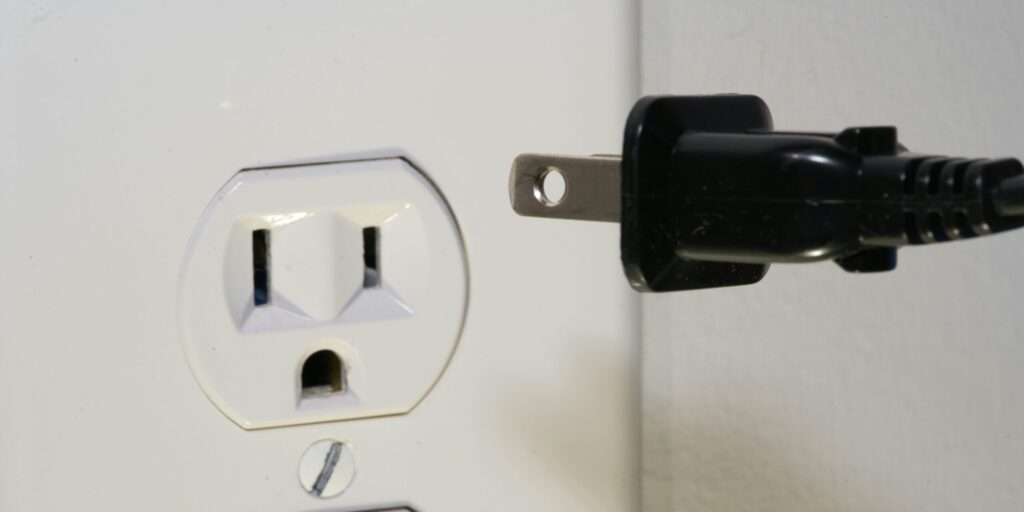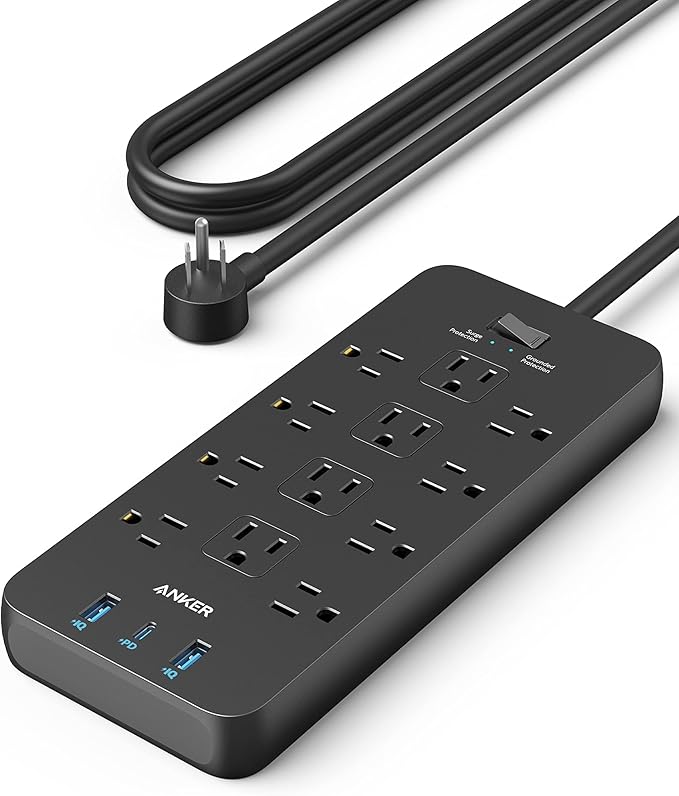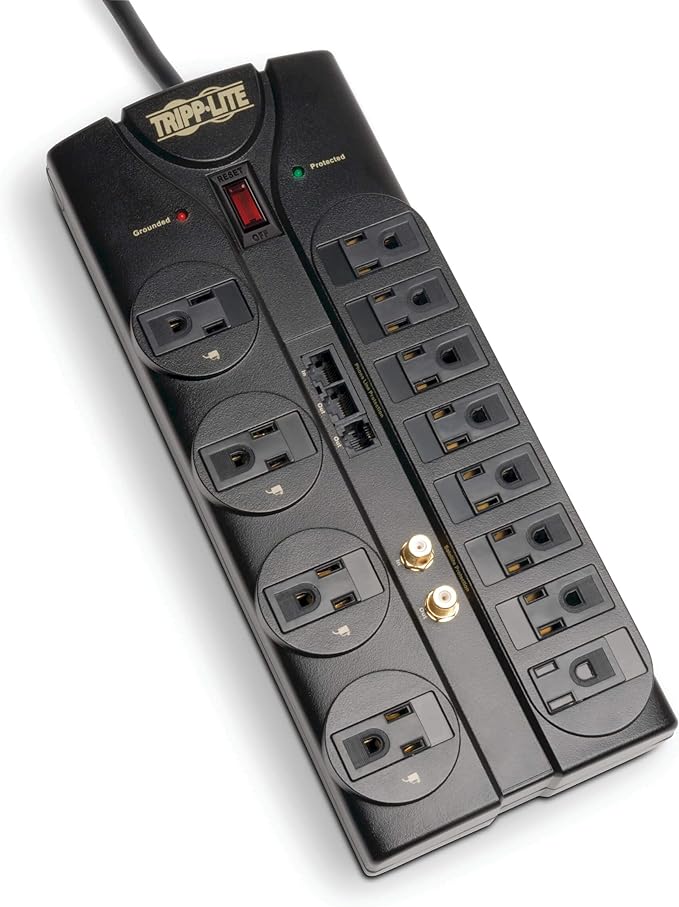We independently review everything we recommend. We may make money from the links on our site.
The Best Surge Protector

Power surges can strike without warning, turning your expensive electronics into paperweights faster than you can say “lightning strike.” Whether it’s a sudden voltage spike from your electrical grid or a massive surge from a thunderstorm, unprotected devices face constant risk. That’s where surge protectors become your electronics’ best friend.
We’ll walk you through everything you need to know about surge protectors. From understanding joule ratings to choosing the perfect model for your specific needs, you’ll have all the information necessary to make an informed decision that keeps your devices safe and your wallet happy.
Everything We Recommend
🏆
The Best Overall
Power up to 15 devices at once with 12 AC outlets, 1 USB-C, and 2 USB-A ports.
Rapid 20W USB-C charging boosts your iPhone 13 from 0% to 53% in just 30 minutes.
8-point safety system ensures full protection with surge defense, fire resistance, and temperature control.
Widely spaced outlets easily fit bulky plugs without blocking others.
Includes Anker 351 Power Strip, 2 screws, 18-month warranty, and $200,000 connected equipment protection.
💎
The Best for Professional Setups
12 AC outlets with built-in coaxial, modem, and Ethernet protection safeguard all your devices, including cable and network gear.
High 2880-joule rating and UL 1449 certification ensure advanced safety with auto shutoff and LED status indicators.
8 ft power cord with right-angle plug and wall-mount keyholes offer flexible setup behind furniture or on walls.
Includes lifetime warranty and $250,000 connected equipment insurance for total peace of mind.
Best for Audio/Video Professionals
Reduces AC line noise and contamination for superior audio/video clarity with advanced linear filtering.
Features Series Multi-Stage Protection Plus (SMP+) and automatic voltage shutdown for maximum surge defense.
Zero ground contamination circuitry ensures pure AC power to protect high-end A/V equipment.
Built-in cable, satellite, and Telco connectors provide comprehensive protection for connected devices.
Ideal for pro audio setups, DJ rigs, and home entertainment systems with trusted power conditioning technology.
Surge Protection: The Science Behind Your Safety
Before diving into product recommendations, let’s understand what makes surge protectors tick. At their core, surge protectors use Metal Oxide Varistors (MOVs) to divert excess voltage away from your connected devices. When voltage exceeds safe levels, these components redirect the surplus energy to the ground wire, protecting your electronics from damage.
The effectiveness of this protection depends on several key factors. Response time matters tremendously because surges can last mere nanoseconds. Modern surge protectors respond within one nanosecond, which is fast enough to prevent damage to sensitive electronics. The clamping voltage, also known as the let-through voltage, determines at what point the protector begins absorbing excess energy. Lower numbers indicate better protection since the device starts working sooner.
Joule Ratings: The Heart of Surge Protection
The joule rating of your surge protector determines how much energy your surge protector can absorb. The higher the joule rating, the greater the protection. Think of joules as your surge protector’s energy absorption capacity. Once this capacity is depleted through multiple surge events, the protection diminishes significantly.
If you’re trying to protect things like cell phones, basic laptops, printers, routers, and copiers, you’ll want a surge protector with a rating between 1,000 and 2,000 joules. However, units with surge protector ratings of 1000 to 2000 joules will provide sufficient protection for power tools and office equipment such as printers, copiers, and routers, while the highest joule ratings—2000 and above—are for home theater components, gaming systems, and other high-value electronics.
For computers specifically, it is recommended to use a surge protector with 2000 joules or higher. This high surge protector’s joule rating offers strong protection against voltage spikes and power surges, ensuring the safety and longevity of your computer’s sensitive electronic components.
Best Surge Protector Our Picks
Picture this: you’re working from home, your desk is cluttered with devices, and you’re constantly playing outlet musical chairs. The Anker 12 Outlets Surge Protector changes this daily frustration into seamless productivity. This powerhouse features 12 AC outlets, 1 USB-C port, and 2 USB-A ports, with 2100 joules of surge protection that keeps your tech arsenal safe while decluttering your workspace.
What makes this Anker model a game-changer is its thoughtful design for modern life. The 20W USB-C port can charge your iPhone 13 from 0-53% in just 30 minutes, meaning you can power up your phone, tablet, and laptop simultaneously without hunting for separate chargers. The flat plug design slides behind furniture without forcing you to pull your desk away from the wall – a small detail that makes a huge difference in tight spaces.
The 5-foot cord strikes the perfect balance between reach and practicality, while the compact form factor doesn’t dominate your floor space like bulkier alternatives. Whether you’re setting up a home office, dorm room, or entertainment center, this surge protector adapts to your needs without compromising protection or convenience.
When your livelihood depends on your electronics, you need more than basic protection – you need the Tripp Lite TLP1208SAT. This professional-grade surge protector delivers 2,880 joules of protection with 12 outlets and an 8-foot cord, but what sets it apart is its comprehensive communication line protection that basic surge protectors simply can’t match.
Built-in RJ11, RJ45, and Type F coax jacks prevent surges from damaging your networking equipment, making it perfect for home offices, small businesses, or anyone with complex setups involving internet, phone, and cable connections. Imagine a lightning strike hitting your building – while your neighbors deal with fried modems and routers, your equipment stays protected thanks to the multi-line defense system.
The diagnostic LEDs act like a health monitor for your electrical environment, showing you exactly what’s happening with your power quality. The right-angle plug and $250,000 insurance coverage demonstrate Tripp Lite’s confidence in its protection. This isn’t just a surge protector; it’s peace of mind for professionals who can’t afford downtime or equipment failure.
If you’ve ever wondered why your audio sounds muddy or your video displays lack clarity, the problem might not be your equipment – it might be your power. The Furman PST-8 doesn’t just protect your devices; it improves their performance by cleaning the electrical current feeding them.
The PST-8 features Furman’s SMP circuit with Linear Filtering Technology (LiFT) and a high-current TVZ-MOV to ensure electronic devices receive clean, filtered AC power. Think of it as a water filter for your electricity – it removes the electronic “dirt” that causes interference, noise, and performance degradation in sensitive equipment.
Linear Filtering Technology eliminates noise from the AC line, delivering clear sound and high-definition video. Musicians notice cleaner audio recordings, gamers experience smoother performance, and home theater enthusiasts see sharper picture quality. The eight outlets provide ample connectivity, while the professional-grade construction ensures years of reliable service.
This power conditioner shines in scenarios where performance matters as much as protection. Recording studios, high-end gaming setups, professional video editing stations, and audiophile systems all benefit from the cleaner power delivery that standard surge protectors can’t provide. It’s the difference between adequate protection and optimized performance.
Essential Features to Consider When Buying
Clamping Voltage: Lower is Better
Also known as the “let-through rating”, this is the voltage at which the surge protector starts to absorb energy. A lower number is better because it means the protector activates sooner. Look for models with clamping voltages below 400V for optimal protection.
Response Time: Speed Matters
Nanoseconds count when protecting sensitive electronics. Modern surge protectors respond within one nanosecond, but cheaper models may take longer. Fast response times prevent damage to delicate circuits in computers, gaming systems, and smart home devices.
Indicator Lights: Know Your Status
Most surge protectors have an indicator light that glows to show when devices are properly protected. Advanced models include separate lights for surge protection, wiring faults, and grounding issues. These indicators help you identify problems before they damage your equipment.
Warranty and Connected Equipment Coverage
Quality surge protectors include warranties covering both the device and connected equipment. Some manufacturers offer coverage up to $100,000 for damaged electronics, demonstrating their confidence in their protection capabilities.
Installation and Placement: Getting the Most Protection
Proper installation significantly impacts your surge protector’s effectiveness. Connect your surge protector directly to a grounded wall outlet rather than daisy-chaining multiple units. This ensures maximum protection and prevents dangerous overloading.
Place your surge protector in a well-ventilated area away from heat sources. Avoid cramped spaces where heat can build up, as excessive temperatures reduce the lifespan of internal components. Keep the unit accessible for easy monitoring of indicator lights and power switches.
Consider the cord length carefully. Longer cords provide placement flexibility but may increase voltage drop. Six-foot cords work well for most applications, while eight-foot options suit larger rooms or awkward outlet locations.
Maintenance and Replacement: Keeping Your Protection Current
The joule rating that MOVs offer will gradually be depleted after each power surge event, which means surge protectors don’t last forever. Monitor your indicator lights regularly and replace units when protection indicators no longer illuminate.
Replace surge protectors every three to five years, even without visible damage. Age degrades internal components, reducing protection effectiveness. If your area experiences frequent storms or power issues, consider more frequent replacement.
Keep receipts and documentation for warranty claims. Quality manufacturers honor their guarantees, but you’ll need proof of purchase for coverage. Register your product when possible to simplify future warranty processes.
Common Mistakes to Avoid
Many users make critical errors that compromise their protection. Never plug a surge protector into another surge protector, as this creates fire hazards and reduces effectiveness. Similarly, avoid using surge protectors with high-power appliances like space heaters or refrigerators, as these can overload the circuit.
Don’t assume all power strips include surge protection. Basic power strips provide additional outlets but offer no protection against voltage spikes. Look for clear labeling indicating surge protection capabilities and joule ratings.
Placement matters more than most people realize. Avoid placing surge protectors on carpets where they can accumulate dust and hair, which creates fire hazards. Hard surfaces provide better heat dissipation and easier cleaning access.
Surge Protection for Different Device Types
Home Theater Systems
Entertainment systems require robust protection due to their complexity and value. Look for surge protectors with at least 3,000 joules and coaxial protection for cable connections. EMI/RFI filtering improves picture and sound quality by reducing electrical interference.
Gaming Setups
Gaming consoles, PCs, and monitors need consistent power quality for optimal performance. Choose surge protectors with 2,000+ joules and multiple outlets to accommodate controllers, charging stations, and accessories. USB ports add convenience for device charging.
Home Office Equipment
Computers, printers, and networking equipment require reliable protection to prevent data loss and hardware damage. Surge protectors with telephone and Ethernet protection safeguard communication lines. Battery backup units with surge protection provide additional security for critical systems.
Smart Home Devices
Connected devices face unique risks from power line communication interference. Look for surge protectors with advanced filtering capabilities that won’t interfere with smart home protocols. Some models include smart features like remote monitoring and control.
The Future of Surge Protection
Surge protection technology continues evolving with advancing electronics. Smart surge protectors now offer smartphone apps for remote monitoring and control. Some models include energy monitoring features that track power consumption and costs.
Advanced filtration systems address increasing concerns about power quality in modern electrical grids. As renewable energy sources become more prevalent, power quality issues may increase, making robust surge protection even more important.
Making Your Final Decision
Choosing the right surge protector depends on your specific needs and budget. For most users, the Anker 12 Outlets Surge Protector (2100J) provides excellent protection and modern convenience with its USB charging capabilities and compact design. Those running professional setups or home offices with networking equipment should consider the Tripp Lite TLP1208SAT for its comprehensive communication line protection and robust 2,880-joule rating. Audio/video professionals and anyone seeking performance enhancement alongside protection will find the Furman PST-8 Power Conditioner invaluable for its advanced filtering technology.
Remember that surge protection is insurance for your electronics. The difference between a $50 surge protector and a $150 power conditioner can save you thousands in equipment replacement costs. Consider your total investment in connected devices when choosing protection levels – a musician with $10,000 in studio equipment needs different protection than someone with basic home electronics.
Conclusion: Protecting Your Investment
Surge protectors represent one of the most cost-effective ways to protect your valuable electronics. By understanding joule ratings, clamping voltages, and response times, you can make informed decisions that keep your devices safe. Whether you choose a basic model for simple protection or a premium unit for comprehensive coverage, any surge protector beats no protection at all.
Remember to replace your surge protectors regularly and monitor their status indicators. With proper selection and maintenance, these devices will serve as reliable guardians for your electronic investments, providing peace of mind during storms and power quality issues.
Don’t wait for the next power surge to damage your devices. Invest in quality surge protection today and enjoy the confidence that comes with knowing your electronics are safe from electrical threats.


